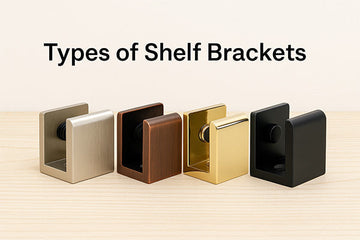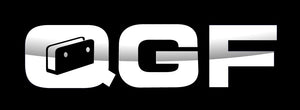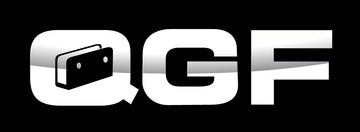
Shelf brackets are the hidden heroes of shelving systems. While the shelves themselves take the spotlight for displaying books, décor, or glassware, brackets quietly provide the strength, stability, and support that keep everything in place. Whether made of glass, wood, or metal, a shelf is only as strong as the brackets holding it.
The wrong bracket choice can result in sagging shelves, damaged walls, or even safety hazards. The right bracket not only ensures your shelf stays secure but also complements your interior design.
Shelf brackets also determine how much weight you can store. They affect the spacing between shelves, influence the shelf’s alignment, and in many cases, add to the aesthetic of the installation. Choosing the right one means balancing function, style, and compatibility with your wall and shelf material.
Types of Shelf Brackets
On the market, you’ll find different types of shelf brackets tailored to different needs. The Quality Glass Fittings range includes several styles designed primarily for glass shelving but adaptable for other lightweight materials.
1. Round Shelf Brackets
Round brackets such as the SS-602 or SS-603 series are a sleek, minimal option that blends into modern interiors. They typically feature a rounded profile, which softens the look and works well with both glass and acrylic shelves.
These often include a rubber insert to protect the glass edge from chipping and a grub screw to secure the shelf in place. They are discreet enough for display shelving in kitchens, bathrooms, or retail spaces where the bracket shouldn’t draw attention.
2. Square Shelf Brackets
Square brackets like the SS-607 series have a more geometric, contemporary feel. The clean lines complement modern furniture and provide a slightly more robust aesthetic than round brackets.
Some square brackets offer adjustable clamping, making them suitable for a range of glass thicknesses (commonly between 6mm and 10mm). They’re often finished in chrome or satin nickel, so they match well with other hardware such as door handles or railings.
3. Small Angular Adjustable Shelf Grips
Models like the SB-4050 are compact but highly functional. The angular design makes them ideal for smaller glass shelves, such as those used in bathrooms for toiletries or in living rooms for decorative items.
Their adjustable grip allows them to accommodate different shelf thicknesses, and the angled style can be used in tighter spaces where a full-size bracket wouldn’t fit.
4. Decorative Support Brackets
While the primary focus of the Quality Glass Fittings selection is on minimal modern brackets, there are also more decorative options available on the market in general — including ornate cast iron or brass brackets for traditional interiors. These may not be part of the current product listing, but they remain an important style category for those matching historical or vintage décor.
Common Materials Used in Shelf Brackets

The material of a shelf bracket directly impacts its durability, finish, and suitability for certain environments.
1. Metal (Chrome, Satin Nickel, Stainless Steel)
The most popular choice for modern shelving brackets is metal. Chrome-plated brackets provide a polished, reflective finish perfect for contemporary spaces, while satin nickel offers a softer, matte appearance. Stainless steel is often used in high-moisture environments such as bathrooms because of its corrosion resistance.
2. Rubber Inserts
Although not structural, rubber inserts are critical in glass shelf brackets. They cushion the glass, preventing edge chipping and reducing vibration or slippage. They also help absorb minor impacts, extending the life of the shelf.
3. Aluminium Alloys
Lightweight yet strong, aluminium alloys are sometimes used for brackets where corrosion resistance and weight savings are priorities. They’re ideal for minimalist designs.
How to Choose the Right Size and Load Capacity
When selecting shelf brackets, size and load capacity should be top priorities.

1. Shelf Thickness Compatibility
Glass shelf brackets are rated for specific thicknesses — often 4mm, 6mm, 8mm, 10mm, or 12mm. Using a bracket that’s too large can result in a loose fit, while one that’s too small won’t hold the glass securely. Adjustable brackets, such as certain Quality Glass Fittings models, solve this by clamping securely to multiple thicknesses.
2. Load Capacity
Many standard glass brackets are rated for around 10 kg per pair when installed correctly into a solid wall. This means that a pair of brackets can support a moderate collection of glasses, books, or decorative items. However, if your shelf will hold heavier loads — such as multiple potted plants or large electronics — opt for heavy-duty brackets or install additional supports.
3. Shelf Depth and Bracket Projection
The bracket projection (distance from the wall) should match or slightly undercut the shelf depth. If the shelf is too deep compared to the bracket, the load may cause tipping or excessive bending.
4. Wall Material
Brick, concrete, and stud walls all have different holding capacities. A bracket that holds perfectly in brick may fail if fixed into drywall without proper anchors.
Mistakes to Avoid When Buying Shelf Brackets

- Ignoring Weight Ratings
Assuming any bracket will hold any load is a recipe for disaster. Always check manufacturer specifications.
- Choosing the Wrong Finish
Chrome looks great but may show water spots in a bathroom; satin nickel hides smudges better. Select finishes based on maintenance as well as looks.
- Mismatching Brackets to Shelf Material
A bracket designed for wood may not secure glass properly. Glass requires clamping or cushioning.
- Poor Quality Fasteners
Even the best bracket can fail with substandard screws. Use rust-resistant, heavy-duty fixings appropriate to your wall type.
- Overlooking Aesthetics
Brackets are visible — especially with glass shelving. Select a design that complements the overall room décor.
Tips for Installing Shelving Brackets
- Use a Spirit Level
Uneven brackets will cause the shelf to sit at an angle, which is both unattractive and potentially unstable.
- Mark Drilling Points Carefully
Once drilled, holes are permanent. Double-check measurements and ensure they align horizontally.
- Consider Stud Locations
In plasterboard walls, fix brackets into studs whenever possible. For solid walls, use heavy-duty wall plugs.
- Secure with Grub Screws
For glass shelves, tighten grub screws enough to hold securely but avoid over-tightening, which could crack the glass.
- Maintain the Finish
Wipe brackets regularly with a soft cloth to prevent tarnishing, especially in bathrooms and kitchens.
Conclusion
Shelf brackets may be small components, but they play a massive role in both safety and style. Choosing the right type — whether round, square, angular, or decorative — requires balancing load capacity, material compatibility, and design appeal. The Quality Glass Fittings range offers stylish, functional options that work particularly well with glass shelving. By considering thickness compatibility, weight ratings, and installation best practices, you can create shelving that’s not only secure but also enhances your interior space. With the right shelf brackets in place, you can enjoy the freedom to display and store items confidently — knowing your shelves are as beautiful as they are strong.

